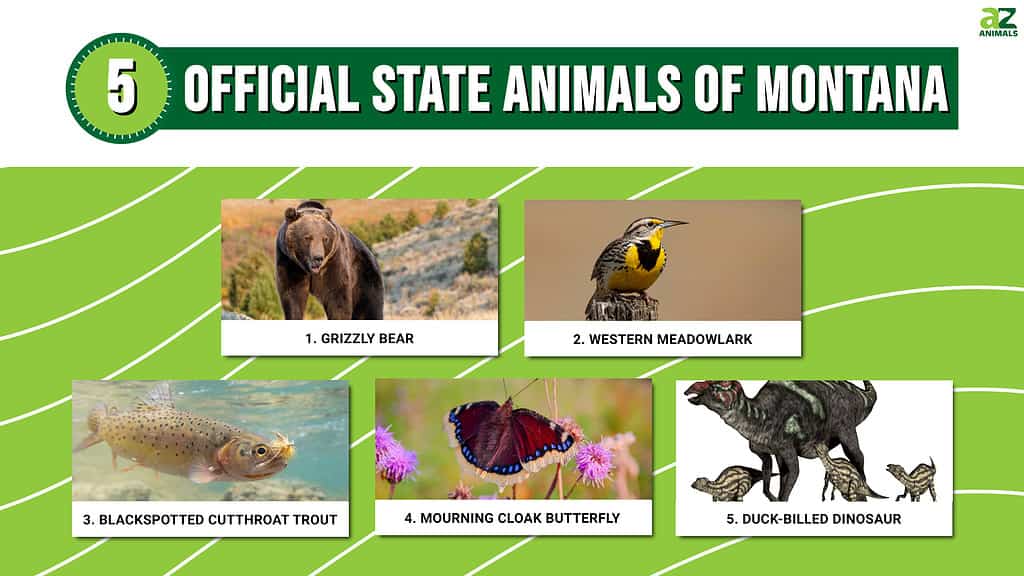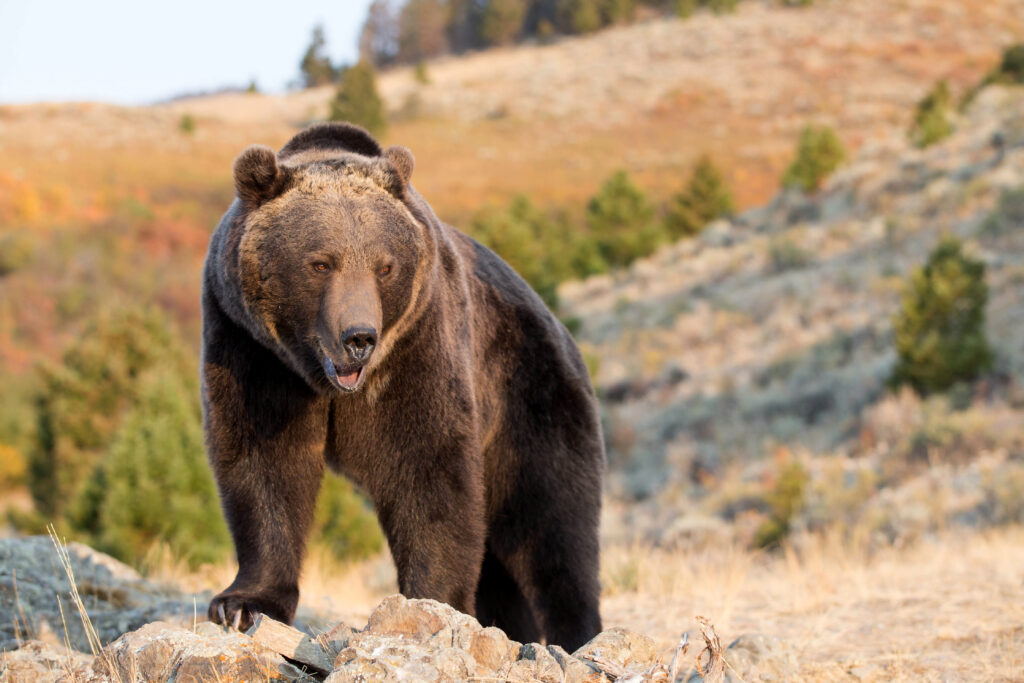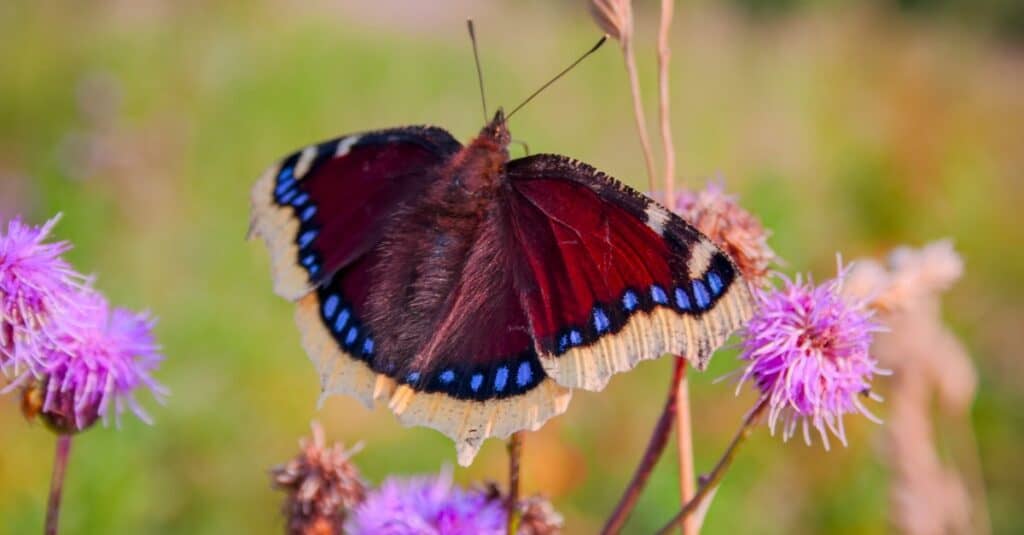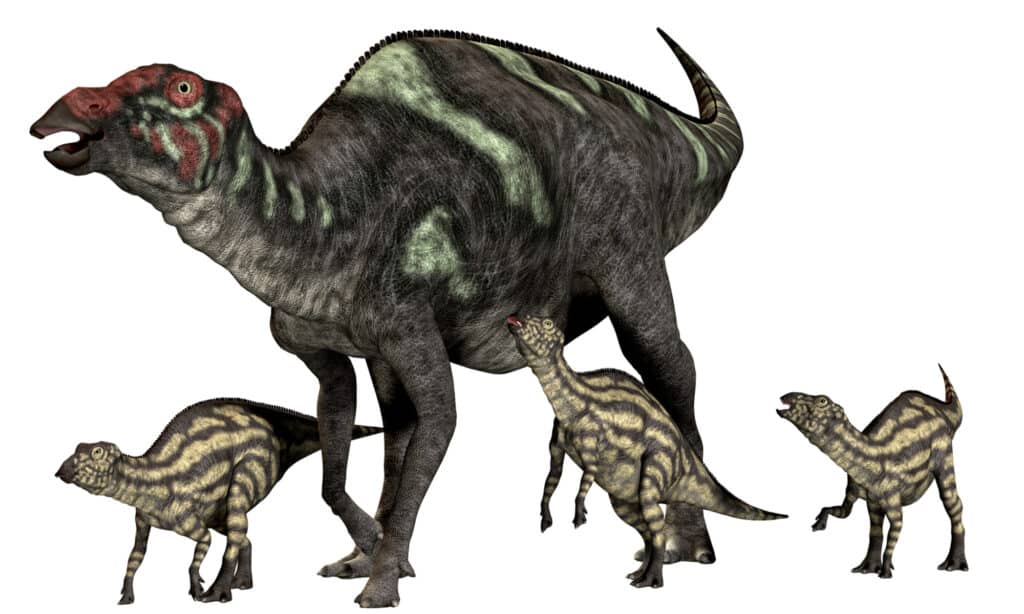Montana is a state unlike any other, filled with breathtaking natural beauty and endless possibilities. Visitors from all over the world come here year after year to experience the state’s astonishing range of landscapes, national parks, wilderness areas, recreation opportunities, and mountain views that stretch as far as the eye can see. There is something truly inspiring about the Big Sky Country, and its official state symbols seem to reflect that magical quality. Let’s take a closer look at the five official state animals of Montana and discover how they symbolize the state’s iconic qualities!

1. Montana’s Official State Animal: Grizzly Bear (Ursus arctos horribilis)

One of the grizzly bear’s most striking features is its large shoulder hump made of powerful muscles.
©Dennis W Donohue/Shutterstock.com
In 1983, the grizzly bear was designated as the official state animal of Montana. 425 schools across the state had multiple elections to choose Montana’s state animal, complete with campaigns, posters, and even speeches. Today, there are only 1,000 grizzly bears living in the lower 48 states, while in the 1800s there were an estimated 50,000 or more.
Montana was the first to begin conservation work to protect grizzly bears back in the 1920s. Historically, grizzly bears lived all throughout Montana, but today they are typically only found in the western half of the state. They are now listed as a species of special concern in Montana, which is home to the largest grizzly bear population in the U.S., outside of Alaska.
Grizzly bears are formidable predators that stand 5 to 8 feet tall on their hind legs. They can weigh up to 1,500 pounds and run up to 35 miles per hour! Grizzly bears in Montana are a subspecies of brown bears. Their fur is usually light brown, but it can also be blonde, white-tipped, or a deep dark brown color. One of their most striking features is their large shoulder hump, which is made of powerful muscles attached to the bear’s backbone. This group of muscles gives the grizzly incredible strength for digging to unearth delicious food and build dens.
2. Montana’s Official State Bird: Western Meadowlark (Sturnella neglecta)

Sue to their beautiful melodies, sometimes it’s easier to hear western meadowlarks than it is to see them.
©iStock.com/photographybyJHWilliams
Also promoted by Montana’s school children, the western meadowlark became the official state bird in 1931. These striking birds have black and white patterned wings with bright yellow throats and chests. Their beaks are long and thin and there is a very distinct black V-shaped marking on their chests.
It is quite common to see western meadowlarks in Montana’s agricultural and grassland areas as they sit on fence posts across the landscape. However, sometimes it’s easier to hear these birds than it is to see them due to their unique songs. Meadowlarks have beautiful melodies that usually start with one to six pure whistles. Male western meadowlarks can learn up to 12 songs and sometimes they even change them when new stimuli come into their area.
In addition to their flute-like melodies, western meadowlarks also build very unique nests in the ground. Found in meadows and grassy fields, the birds weave their cup-shaped nests with bark and dried grasses. They often weave their nests right into the vegetation growing from the ground. Some nests will have an additional grass roof or even a very long woven-grass entry tunnel.
3. Montana’s Official State Fish: Blackspotted Cutthroat Trout (Oncorhynchus clarki)

Cutthroat trout were first described by William Clark (of the Lewis and Clark Expedition) in Montana.
©iStock.com/christiannafzger
Although there are many different kinds of fish in Montana, the most famous is the trout. When Norma Ashby, an avid fisher, discovered that Montana had yet to declare a state fish, she decided to campaign for the trout — or more specifically, the blackspotted cutthroat trout. However, it was important to the people of Montana that the fish truly represented the values of the state.
Cutthroat trout, it turns out, were first described by none other than William Clark (of the Lewis and Clark Expedition) right here in Montana! In addition, the cutthroat trout is said to represent the embodiment of the Montana way of life. A living symbol of quality and tenacity, these resilient fish require pristine environments in order to thrive. Like cutthroat trout, the people of Montana continually strive to maintain their hard-fought way of life, even as other states around them change. Montanans accept nothing less than the best in order to protect and preserve what is so special about their state. The blackspotted cutthroat trout became the official state fish of Montana in 1977.
4. Montana’s Official State Butterfly: Mourning Cloak Butterfly (Nymphalis antiopa)

The mourning cloak
butterfly
uses its dark velvety wings to absorb the warmth of the sun.
©iStock.com/Anatoliy Berislavskiy
One of the first butterflies that you will see in the spring is the state’s official state butterfly: the mourning cloak butterfly. These beautiful creatures sometimes emerge even before the snow has melted across the state! The mourning cloak butterfly became the official state butterfly in 2001. Its name comes from the striking coloration of its wings, which resemble the dark cloaks that many people wear when they are mourning the loss of a loved one.
The butterfly’s velvety wings also have delicate yellow edges and tiny iridescent blue spots. These iconic insects are easy to identify, as there is no other butterfly that looks quite like them! They use their dark wings to absorb the warmth of the sun as they bask on tree trunks across Montana. They are quite large as well, with wingspans that can reach up to 4 inches! The caterpillars are a good size too, reaching lengths of up to 2 inches long. Mourning cloak butterfly caterpillars have black bodies with eight brightly red-orange spots that run down the middle of their backs. They also have short hairs with white dots and spikey black spines covering their bodies.
5. Montana’s Official State Fossil: Duck-Billed Dinosaur (Maiasaura peeblesorum)

The duck-billed dinosaur was an herbivore and lived in incredibly large herds.
©Catmando/Shutterstock.com
Named the official state fossil of Montana in 1985, Maiasaura peeblesorum — or the duck-billed dinosaur — has a unique and important history in the paleontology world. Fossils were first discovered in 1978 by Marion Brandvold in an area of Montana that is now known as “Egg Mountain.” What was so unique about Brandvold’s revolutionary find was it wasn’t just a single dinosaur — it was an entire nest of eggshells, baby and juvenile dinosaurs, and even an unhatched dinosaur embryo! This was the very first time scientists had found evidence that some dinosaurs lived in colonies where they nurtured and raised their young! In fact, the dinosaur’s name, Maisasaura, comes from Greek and means “good mother reptile.”
The famous duck-billed dinosaur was around 30 feet long with a flat snout like a duckbill. Baby dinos, however, hatched when they were only 14 inches long and weighed just 1.5 pounds! The duck-billed dinosaur was an herbivore and lived in incredibly large herds. Scientists think that these unique dinosaurs didn’t leave their eggs like some of today’s reptiles, but instead brought food back to the nest for their babies to eat. The dinosaur fossils found at Egg Mountain suggest that baby duck-billed dinosaurs were too small to walk, similar to baby birds.
Summary of 5 Official State Animals of Montana
Here’s a recap of five of Montana’s state animals that we took a look at.
| Number | Category | Animal | Scientific Name | Year Designated |
|---|---|---|---|---|
| 1 | State Animal | Grizzly Bear | Ursus arctos horribilis | 1983 |
| 2 | State Bird | Western Meadowlark | Sturnella neglecta | 1931 |
| 3 | State Fish | Blackspotted Cutthroat Trout | Oncorhynchus clarki | 1977 |
| 4 | State Butterfly | Mourning Cloak Butterfly | Nymphalis antiopa | 2001 |
| 5 | State Fossil | Duck-Billed Dinosaur | Maiasaura peeblesorum | 1985 |
The photo featured at the top of this post is © Pat de la Harpe/Shutterstock.com
FAQs (Frequently Asked Questions)
What is the official state animal of Montana?
The official state animal of Montana is the Grizzly Bear (Ursus arctos horribilis).
What are Montana's other state symbols?
Montana several official state symbols, including:
- State Animal: Grizzly Bear (Ursus arctos horribilis)
- State Bird: Western Meadowlark (Sturnella neglecta)
- State Fish: Blackspotted Cutthroat Trout (Oncorhynchus clarki)
- State Butterfly: Mourning Cloak Butterfly (Nymphalis antiopa)
- State Fossil: Duck-Billed Dinosaur (Maiasaura peeblesorum)
- State Flower: Bitterroot (Lewisia rediviva)
- State Grass: Bluebunch wheatgrass (Pseudoroegneria spicata)
- State Tree: Ponderosa pine (Pinus ponderosa)
- State Gemstone: Sapphire and Montana moss agate
- State Soil: Scobey
- State Arboretum: The University of Montana – Missoula
- State Ballad: “Montana Melody” (written by LeGrande Harvey and Carleen Harvey)
- State Lullaby: “Montana Lullaby” (written by Ken Overcast and Wylie Gustafson)
- State Song: “Montana” (written by Charles Cohan and Joseph E. Howard in 1910)
Thank you for reading! Have some feedback for us? Contact the AZ Animals editorial team.






